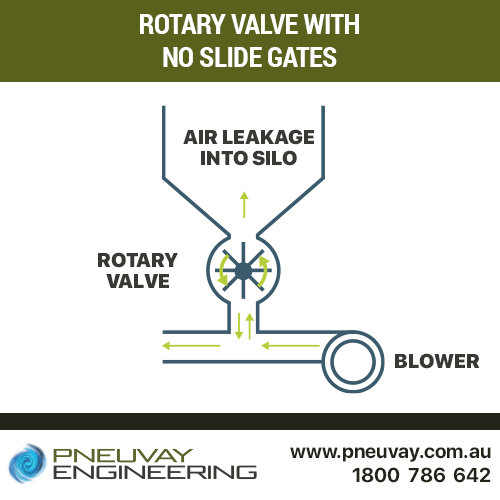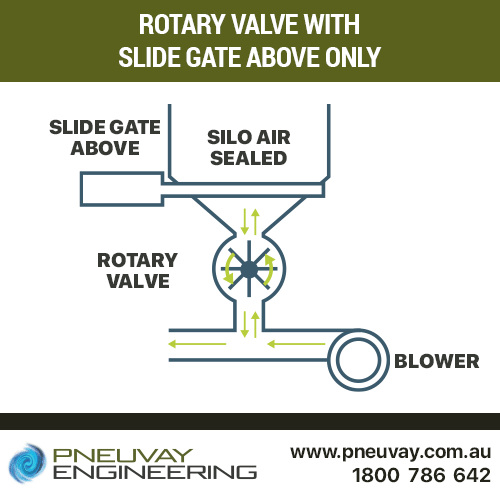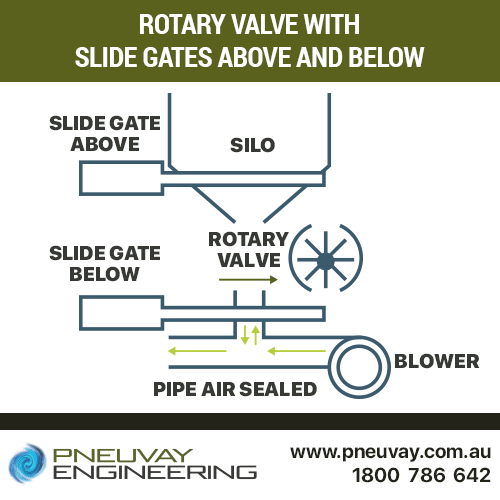See our latest projects and be updated with recent news and features
happening in the world of pneumatic conveying, materials handling
and industrial vacuum systems.
See our latest projects and be updated with recent news and features
happening in the world of pneumatic conveying, materials handling
and industrial vacuum systems.

Friday, August 30, 2019
Slide gates can produce major operational benefits in lean phase pneumatic conveying systems that use rotary valves. We provide an overview of a typical lean phase pneumatic conveying system that uses rotary valves. We then show how slide gates can be applied to greatly improve the efficiency and functionality of this type of manufacturing plant.
Pneumatic conveying using lean phase is often the most efficient and cost-effective method to transfer dry bulk powders or granular materials. This production process is commonly found in industries that use dry bulk powders or granular materials such as:
Lean phase pneumatic conveying systems are typically deployed in a manufacturing plant where these materials are:
The positive pressure is provided by a blower, and typically charges the system to no more than 205 Kpa (two atmospheres). The best component to regulate the feeding of material from the silo to transfer pipe at this pressure range is a rotary valve. It is versatile and can handle a wide range of bulk powders and granular materials, where it:
This configuration appears robust and relatively straightforward, however within the rotary valve there are some subtle flaws that can negatively impact overall performance.

Rotary valve with no slide gates
The rotary valve is, in actual fact, the source of a small amount of air leakage within the system. The amount of negative performance generated by this air leakage depends on several specific aspects. For example, the more silos connected to a single conveying pipe the greater negative performance can result from the air leakage from rotary valves.
Rotary valves are often referred to as 'rotary airlocks.' The use of the term 'airlock' is, however, a misconception; they are unable to provide an air seal between the material inlet and outlet from the positive pressure generated by the blower. The amount of air leakage from the positive pressure is reduced by increasing the number of vanes on a rotary valve; however, a small gap is required between the vanes and its housing, to prevent friction and allow smooth rotation. As a result, some amount of air will pass through a rotary valve and into the silo.
Saltation speed is the minimum air speed within a transfer pipe for materials to stay airborne. Air leakage within the lean phase pneumatic conveying system will lower this air speed. If the air speed gets lower than the saltation speed, material will drop out of air flow, form plugs along the transfer pipe and cause product loss. Expensive and disruptive maintenance is required to remove the build-up of material in the transfer pipe. The lean phase pneumatic conveying system must be shut down to allow the transfer pipes to be manually decoupled and cleaned.
Air leakage from the rotary valve can lead to an unnecessary oversizing of the blowers. In order to maintain saltation speed a higher capacity blower may be required. This higher capacity is needed to make up for the reduction in air speed from the air leakage. Higher capacity blowers use significantly more energy. Unnecessary oversized blowers therefore make the lean phase pneumatic conveying system energy inefficient.
Air leakage is a source of wear and tear on the rotary valve. Material that is blown back into the silo through the gaps in the return side of the rotary valve will cause wear to its vanes and housing. To make matters worse, the rate of wear and tear from blowback will increase over time. The greater the gaps become, the greater the amount of air leakage. The greater the amount of air leakage, the more wear occurs. Blown back material may enter bearings with the rotary valve and cause a mechanical failure. This would result in expensive and disruptive maintenance.
Air leakage from rotary valves can have significant impact on the overall efficiency and performance of the lean phase pneumatic conveying system. Slide gates can be applied to greatly improve the efficiency and functionality of this type of manufacturing plant and mitigate issues that accompany rotary valves.
To reduce the impact of air leakage from a rotary valve, a slide gate (Vortex Clear Action Gate) can be fitted above it at the bottom of the silo. This serves as an air seal and barrier between the silo and the transfer pipe and allows for:
This benefit only occurs when material is not required from the silo and the slide gate is closed. When material is not required from the silo, the slide gate:
A slide gate above the rotary valve allows for easier maintenance to be performed on the rotary valve itself. This is because the slide gate can isolate the silo from the rotary valve when it is full of material.
Read more on the Vortex Clear Action Gate here

Rotary valve with slide gate above only
To further reduce the air leakage from a rotary valve, a slide gate (Vortex Maintenance Gate) can be fitted below it at the top of the connection to the transfer pipe. This serves as an air seal between the rotary valve and the transfer pipe and has the same features of the Vortex Clear Action Gate, as well as having a narrow profile and being live-loaded with wear-compensating seals.
When this gate is closed, it will prevent any loss of positive pressure while the rotary valve is being maintained, rebuilt or replaced. All other silos connected to the transfer pipe will be undisturbed and can remain fully operational. A slide gate above and below the rotary valve below allows the rotary valve and silo to be isolated, eliminating the need to empty the silo if a rotary valve has a mechanical failure.
Read more on the Vortex Maintenance Gate here and see a video of it in operation.

Rotary valve with slide gates above and below
Pneuvay is the Australian market leader in the manufacture of lean phase pneumatic conveying systems, rotary valves and slide gates. We produce systems for many large manufacturers, and are renowned for our turnkey and best fit solutions for manufacturing factories looking to:
If you have any questions in relation to lean phase pneumatic conveying systems, feel free to call us on 1300721458 or send us a message via our Pneuvay website contact page or Pneuvay Facebook page.
Get social with us and see the latest news items from:
We recently made an exciting visit to Vortex in the USA to enhance our capabilities as a regional agent for their products.
Discover the valuable insights we gained and why we are proud to partner with Vortex!
Pipe and Tube Compression Couplings
Industrial Dust Collectors Systems
Dust Collectors Filters, Cartridges and Bags
Pneuvay Engineering Pty Ltd - Copyright 2020
ABN 49 006 027 541
